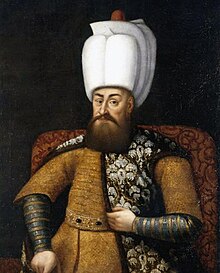Murad III
Murad III (* July 4, 1546 ; † January 15/16, 1595 ) was Sultan of the Ottoman Empire from 1574 to 1595 .
Life
Murad was the eldest son of Selim II and the native Venetian Nurbanu . He succeeded his father to the throne on December 15, 1574. The affairs of the Empire continued to be conducted by the powerful Grand Vizier Sokollu Mehmed Pascha until his assassination in October 1579. His authority was increasingly undermined by the influence of the harem , which culminated during Murad's reign. The most important role was played by Safiye , the sultan's favorite wife, a Venetian woman from a noble family whose father had been governor of Corfu , and who had been captured by Turkish corsairs as a child and sold to the harem.
Murad is not certified as having leadership qualities. He was considered good-natured, but could also be cruel on occasion. At the beginning of his reign, as had become the custom, he had his five brothers strangled with a bowstring in order to eliminate any competition for the throne. His willpower was weakened early on by opium consumption and constant excesses. He had no political inclination anyway; he spent his time in the company of musicians, poets and buffoons, and he himself worked as a poet with a penchant for mysticism.
His only attempt at reform was the ban on intoxicants, with which the increasing licentiousness of the Janissaries should be contained. It failed because of the resistance of the soldiers. As the first sultan, Murad enriched himself personally, in particular by assigning offices for high monetary payments. This corruption was particularly devastating for the army , which was based on the Tımar system. Fiefs were now confiscated and given to the harem's favorites, and strangers and reâyâ entered the ranks of the janissaries through the same influence . Their discipline became more and more relaxed and their moods more and more inflammatory.
In 1578 a long and costly campaign against Persia began . The costs of the war had to be partially financed through currency devaluation, which in turn led to revolts by the Janissaries.
In 1593, the so-called Long Turkish War broke out in Europe , which lasted until after Murad's death in 1595.
Under Murad III. relations between England and the Porte began . Negotiations with Queen Elizabeth began in 1579 through British traders; In 1580 the first surrenders were signed with England; In 1583 William Harebone came to Constantinople, the first ambassador to the Sublime Porte; and in 1593 business capitulations were signed with England giving it the same rights as the French.
He was buried in his Türbe in the Çekirge district of Bursa .
See also
- Article Talikizâde
literature
- Joseph v. Hammer-Purgstall: History of the Ottoman Empire . Vol. 3: From the accession of Suleiman the First to the death of Selim II (1520–1574) . Vol. 4: From the accession of Murad the Third to the second dethronement of Mustafa I (1574–1623) . 10 vols., Vienna and Pesth. 1827-1836
- Ferenc Majoros, Bernd Rill: The Ottoman Empire 1300-1922. The history of a great power , Marix Verlag, Wiesbaden 2004.
- Gabriel Effendi Noradounghian : Recueil d'actes internationaux de l'Empire Ottoman 1300–1789. Tome I. Paris, Neufchâtel 1897
- John Parry Vernon: A history of the Ottoman Empire to 1730: chapters from the 'Cambridge history of Islam' and 'New Cambridge modern history' . Vol. 1-5. Cambridge University Press, Cambridge 1976.
- Ernst Werner: The Birth of a Great Power - The Ottomans. A contribution to the genesis of Turkish feudalism . Vienna: Hermann Böhlaus successor, Vienna 1985.
- Ernst Werner, Walter Markov: History of the Turks from the beginning to the present . Akademie Verlag, Berlin 1979.
Web links
- http://www.tuerkenbeute.de/kun/kun_bio/Murat3_de.php Badisches Landesmuseum, Karlsruhe: Murad III.
| predecessor | Office | successor |
|---|---|---|
| Selim II |
Sultan and Caliph of the Ottoman Empire 1574–1595 |
Mehmed III. |
| personal data | |
|---|---|
| SURNAME | Murad III |
| BRIEF DESCRIPTION | Sultan of the Ottoman Empire (1574–1595) |
| DATE OF BIRTH | 4th July 1546 |
| DATE OF DEATH | January 15, 1595 or January 16, 1595 |

